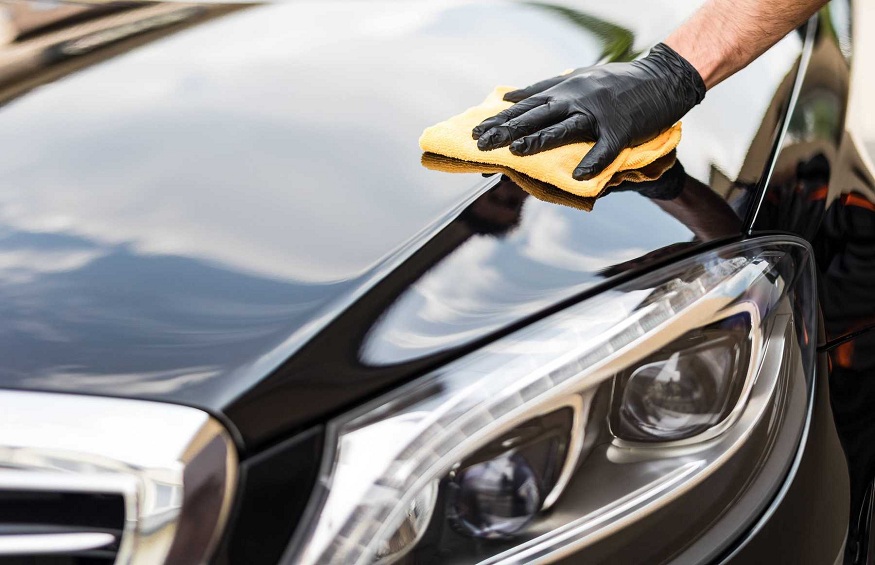Your car is more than simply a means of transportation; it also serves as an investment you want to safeguard and keep in good condition. Keeping the exterior paint in perfect condition is vital for car maintenance.
Your car’s paint finish may suffer over time from exposure to the environment, UV rays, road debris, and pollution, which can result in swirl marks, minor scratches, and a loss of shine. In this situation, automobile polish is proper. The beauty of your car can be restored and maintained significantly by picking the correct car polish.
This detailed guide will explain how to select the best car polish for your vehicle while taking into account the needs that are unique to it.
Understanding Car Polish
Understanding what vehicle polish is and what it does is crucial before choosing it. Car polish is made to make your car’s paint seem better by eliminating flaws and boosting its shine. It accomplishes this by rubbing the surface, which entails removing a thin layer of colour or a clear coat to level the character.
Wax and sealants, which create a protective coating on top of the paint, are different from car polish. Car polish concentrates on the aesthetic side of paint restoration and improvement, while waxes and sealants give protection from the weather.
Assessing Your Car’s Needs
You must first determine the demands to select the best car polish service for your vehicle. The type of polish chosen should be specific to the extent of paint damage or flaws present on the car to treat these problems properly. Here are some things to think about:
1. Paint Condition
Start by examining your car’s paint condition. Look for imperfections like swirl marks, fine scratches, oxidation, or water spots. The severity of these issues will determine the level of abrasiveness required in the car polish.
2. Paint Type
Consider the type of paint on your vehicle. Most modern cars have clear coat paint, a protective layer on top of the base coat. Clear coat paint is what you’re polishing, and choosing a polish that’s compatible with it is essential. Your polish needs will differ if your car has a single-stage color without a clear coat.
3. Color and Finish
The color and finish of your car also matter. Dark-coloured vehicles tend to show imperfections more prominently than lighter ones. Additionally, matte or satin finishes require specific polishes designed for these finishes.
4. Your Goals
Think about your goals for polishing your car. Are you looking for a quick shine enhancement, or do you want to address more significant imperfections? Knowing your objectives will help you choose the right type of polish.
Types of Car Polishes
Car polishes come in various types, each designed for specific purposes and paint conditions. Understanding these types will help you make an informed choice:
- Abrasive Polishes: These have abrasive components that eat away at the clear coat to eliminate flaws, including oxidation, minor scratches, and swirl marks. They come in a range of abrasiveness, from moderate to harsh, so you may pick the one that best suits the requirements of your car.
- All-in-One Polishes: These solutions, also referred to as one-step polishes, provide a composition that combines polishing and protection. They are appropriate for vehicles with minor flaws or for routine maintenance because they are less abrasive than specialized abrasive polishes.
- Finishing Polishes: These are designed to refine the finish after an abrasive class. They are less abrasive and help remove fine scratches left behind by the more aggressive grace.
- Glazes: Glazes are non-abrasive products that make your car’s paint shine more brilliantly without erasing any flaws. They frequently serve as the final step in the finishing process and offer a rich, glossy finish.
- Specialty Polishes: Some polishes are designed for specific tasks, such as removing water spots, restoring headlights, or polishing chrome or metal surfaces.
Choosing the Right Abrasive Level
You must select the appropriate amount of abrasiveness if you decide that an abrasive polish is required to address paint flaws on your car. As was already noted, there are several levels of aggressiveness for abrasive polishes. Here is a general principle:
- Mild Abrasive: Use a gentle abrasive polish for light swirl marks and minor imperfections. These are suitable for regular maintenance and can be used more frequently without causing excessive wear to your clear coat.
- Moderate Abrasive: A mild abrasive polish is ideal for slightly deeper scratches and oxidation. It strikes a balance between correction and safety for your paint.
- Aggressive Abrasive: Reserve bold, abrasive polishes for severe imperfections that require significant paint removal. These should be used sparingly, as they can remove a substantial amount of clear coat if overused.
Consider Ease of Use
The ease of application is an important consideration when choosing a car polish. While some polishes are more accessible to apply, some require more time and skill. Here are some things to take into account:
- Machine vs. Hand Application: While certain polishes can be applied by hand, some are designed to be done using a machine polisher. Machine application generally yields more reliable outcomes, but only with the right tools and training. For novices, hand application is more approachable.
- Drying Time: Check the drying time specified by the manufacturer. Some polishes require longer drying times, which may not be suitable if you’re looking for a quick and easy application.
- Residue Removal: Consider how simple it is to eliminate polish residue after use. Some products leave a tenacious residue that might be difficult to eliminate.
- User Reviews: To understand how user-friendly a specific polish is, read reviews from other auto enthusiasts.
Compatibility with Paint Protection
If you have existing paint protection, such as a ceramic coating or paint sealant, choosing a car polish that is compatible with these products is crucial. Some abrasive polishes can strip away or diminish the effectiveness of certain coatings. Check with the manufacturer or your detailing professional for guidance on compatible products.
Environmental Considerations
Concerns over how car care items affect the environment have grown in recent years. Many automobile polishes contain harsh chemicals and volatile organic compounds (VOCs), which can harm the environment. If you care about the environment, consider selecting a water-based or eco-friendly auto polish. These items generally emit fewer toxic emissions and are safer for the environment.
Seek Professional Advice
Consult a professional if you need help determining the best vehicle polish to use or how to assess your automobile’s unique requirements. Professionals specialising in auto detailing can evaluate your car’s condition and suggest the right tools and methods. They have the knowledge to choose the best abrasive level, strategy, and supplies to produce the desired results with the slightest chance of causing paint damage to your automobile.
The Importance of Testing
Before applying any polish to your entire vehicle, doing a small test spot in an inconspicuous area is a good practice. This spot test allows you to assess how the polish reacts with your car’s paint and whether it achieves the desired results without causing any adverse effects. It’s essential to ensure you won’t unintentionally harm your vehicle’s finish.
Wrapping Up
To preserve and improve your car’s appearance, picking the best polish is essential. You may make an informed choice by analyzing the unique requirements of your vehicle, comprehending the different polish kinds, and taking into account elements like abrasive level, usability, compatibility with current paint protection, and environmental impact.
Remember that proper preparation and technique are equally important as the choice of polish. Whether you’re a DIY enthusiast or rely on professional detailers, a well-chosen car polish can keep your vehicle looking its best for years.






